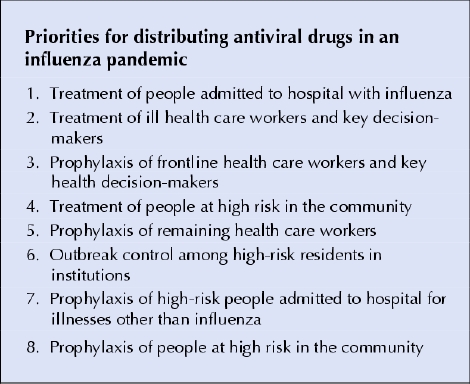The federal government has generated an ambitious plan to stockpile massive quantities of antiviral drugs in readiness for a potential influenza pandemic, to buy scientists precious time to produce a vaccine to fight the new strain.
However, the high cost and limited supply of the most effective drug means Canada will be able to obtain only 30 million of the 221.6 million doses officials believe they will need to treat the 684 000 Canadians most at risk of dying from the virus or who provide essential public services.
The National Antiviral Conference in Winnipeg on Mar. 21 and 22 focused on the use of antiviral drugs to fight an influenza pandemic, which the Public Health Agency of Canada (PHAC) estimates could kill up to 58 000 Canadians (CMAJ 2004;170:785-6). The conference confirmed a federal– provincial plan to stockpile as many as 20 million individual doses of oseltamivir (Tamiflu) and another 10 million doses of other antiviral drugs.
Conference delegates questioned how effective antiviral agents would be in a pandemic. Dr. Joel Kettner, Manitoba's chief public health officer, said they have never been tested in full-blown pandemic conditions.
In a best-case scenario, antiviral drugs would prevent infection in some groups, while helping others weather the virus with reduced critical symptoms, said Dr. Theresa Tam, PHAC associate director of immunization and respiratory infections. Assuming manufacturers have the 6- to 7-month window required to develop a vaccine, these drugs could help Canada avoid widespread death and disruption to the economy, she said (CMAJ 2005;172:623).
In a worst-case scenario, where the strain of influenza that emerges does not lend itself to rapid vaccine development, and infection rates rise to 1918 levels, this small stockpile would likely provide no comfort. Still, the worst case is not an excuse for sitting still, Tam said. “The only thing more difficult than planning for an emergency is having to explain why you didn't,” she added.
Stockpiling antivirals is expensive. Each pill costs $2.50 and an infected person would require about 10. Prophylactic treatment could run to 42 doses. It would cost $75 million to provide 30 million doses.
The drugs are also in short supply; oseltamivir (Tamiflu), the most effective antiviral agent, is produced by a single manufacturer.
The drugs must be started within 48 hours of the onset of symptoms. Neuraminidase inhibitors such as oseltamivir (Tamiflu) and zanamivir (Relenza) hold the greatest potential to control the spread of a virulent new strain of influenza, said Dr. Frederick Hayden, head of infectious diseases at the University of Virginia. Any new strain is more likely to have built up resistance to older inhibitors, including amantadine (Symmetrel) and rimantadine (Flumadine), making them less desirable to stockpile. These drugs also have a higher prevalence of side effects, some severe, said Hayden.
Most conference delegates agreed that 30 million pills might buy researchers just enough time to develop an effective vaccine. “It's a matter of how much insurance you want to buy, and how much insurance can you afford,” said Jill Sciberras, a PHAC senior epidemiologist.
The Public Health Agency of Canada has developed a priority list of groups who would draw from the national stockpile for treatment or as prophyhlaxis (see Box). — Dan Lett, Winnipeg
Box 1.

Footnotes
A longer version of this article was posted Mar. 23, 2005, at www.cmaj.ca


